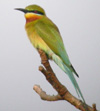
Real Birder
 |
Real Birder |
||||
| |
Namibia 20th to 29th January 2006 |
|
Namibia is a very large country in south west Africa; the capital is Windhoek a very modern city. The population of the country is mainly centred around the few main towns and numbers about 2 million. It is a multi-cultural society and seems very safe for visitors. The trip was organised by Naturetrek of Cheriton in Hampshire and the dates were from 20th to 29th January 2006.
Visas are not required for entry to Namibia. Currency is the Namibian dollar but South African Rands are equally acceptable. Currently the exchange rate is around 10 dollars or Rands to the £. At this point I should mention that meals are not included in the cost of the holiday. At this time of the year it is summer locally and this means very high temperatures with occasional heavy rain; which never lasted long during my trip.
I flew to Gatwick from Glasgow arriving at 15.20 hours. I then had to wait until 20.45 hours to board the Air Namibia flight to Windhoek which left on time at 21.30 hours. The plane was a wide-bodied jet and the service was good; with free drinks and a choice of food. DAY 2 Arriving in Windhoek airport at 08.45 hours, we quickly cleared the usual formalities and I wasted no time in getting out into the fresh air. The guide had not arrived and myself and the other birders spent our time watching the multitude of hirundines that were flying around the airport buildings. When our guide arrived he turned out to be of Bushman extraction. He went by the name of Charles Rhyn and was very pleasant. We set off on the 5 hour run to our first night's stop at the Waterberg Plateau Park rest camp. On the way we stopped at a SPAR market to get some food for our lunch. Along the main roads there are picnic areas and we stopped at one of these for a bite to eat. As we progressed on our way we saw many birds; most of them briefly. A bird that was very evident on many telegraph poles and bushes was Southern Pale Chanting Goshawk. Rollers were also much in evidence.
I awoke at 06.00 hours the following morning and went off with the rest of the party to explore the vegetation along the base of the cliffs. Rock Hyrax and Baboons were obvious and we saw some very rare birds; such as Hartlaub's Francolin, Rockrunner, Violet-backed Starling and Verreaux's Eagle. DAYS 3-5
We stayed in the Etosha area for two days, covering all the game trails in an effort to see as many birds as possible but never stopped at any spot for very long. We had several sightings of Kori Bustard close at hand but had to be content with distant views of Secretary Bird and Blue Crane. Ostrich was another bird that kept its distance. Although the Greater Etosha Salt Pan was dry, a smaller pan (comparatively speaking) known as Little Etosha, held water and consequently many waders and water birds. DAY 6 We turned south and headed for Omaruru; another long drive ensued, which was made longer by the constant brief stops whenever a likely bird was spotted. At Omaruru we stayed in lovely chalets and dined royally in the wonderful camp restaurant. After dinner I set out to look for nightjars and was able to find some but was unable to put a name to them. At the camp waterhole I watched a pair of Blacksmith Plover 'see off' any creature that dared to enter their territory. The following day we explored the game trails around the camp finding, Pearl-spotted Owlet, Groundscraper Thrush, Monteiro's Hornbill and Grey Lourie, to name but a few. DAYS 7-8 We left Omaruru the next morning and set off to Walvis Bay on the Atlantic coast; passing through wonderfully wild sandy and gravel deserts with spectacular views of distant mountains. On the way we noted Long-billed Lark, Ruppell's Korhaan, Tractrac Chat, Capped Wheatear and Long-billed Pipit.
The following morning saw us on a pelagic trip some twenty miles out to sea. The conditions were calm and this probably accounted for the fact that we did not see any albatrosses; however, this was somewhat compensated for by good sightings of Subantarctic Skua, Pomarine Skua, White-chinned Petrel, Wilson's Petrel and European Storm Petrel. DAY 9 Before leaving Walvis Bay to return to Windhoek we managed to find an Orange River White-eye just outside the hotel gates. On our way back to the airport we just had time to visit some sewage works which were very productive, rendering up African Darter, Red Bishop, Cape Shoveler, Hottentot Teal, Red-billed Firefinch plus Diederik and Jacobin Cuckoos . SUMMARY I ended up with a total of 256 identified birds. Had I been able to put a name to all of the birds that I saw, no doubt the final total would have been much greater; however, I am well satisfied with what I achieved. If I am lucky enough to return to Namibia, I shall endeavour to move at a much slower pace over a much longer period of time, in order to savour the wonders of the land that is Namibia. The names used in the Trip List are as laid down in Birds of Southern Africa (Third Edition - 2002) by Sinclair, Hockey & Tarboton.
Frances Gatens |
| ©2012 Real Birder | Home • Photos • Trip Reports• Links • Contact Us |